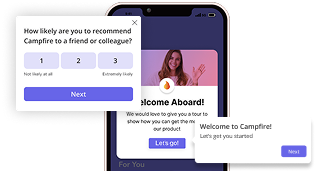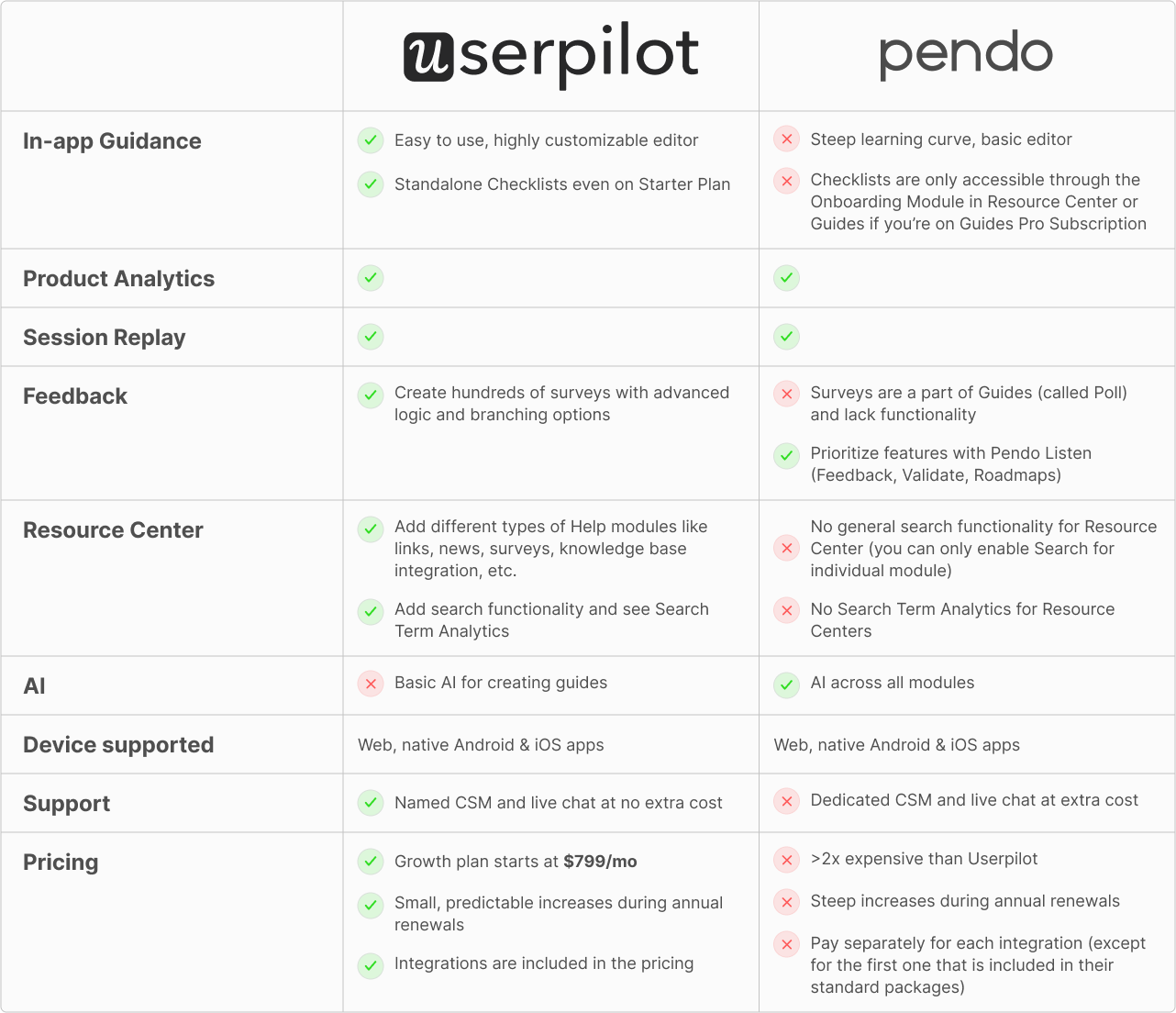
This article has been reviewed and is accurate as of May 2025.
The Pendo Mobile feature is good at what it intends to do: improve the mobile app experience.
But is it really worth it for product management?
While Pendo is known for its top-notch product analytics and in-app guidance features, the mobile offering often receives mixed feedback, especially regarding pricing, implementation complexity, and feature limitations.
Plus, when compared to Userpilot’s mobile features, it seems to provide less value for a higher cost.
So with this in mind, let’s explore:
- What Pendo Mobile offers.
- Whether Pendo Mobile is worth the investment.
- Why Userpilot Mobile may be the smarter choice.
Try Userpilot Now
See Why 1,000+ Teams Choose Userpilot

Pendo for mobile apps: An overview
Pendo’s mobile feature is designed to help businesses understand mobile user behavior and engage them effectively. It supports both iOS and Android devices and integrates with mobile frameworks like React Native, Flutter, and native SDKs. Plus, it connects with the web version so you can track the user experiences across mobile and web platforms.
To start using Pendo mobile, you need to install the Pendo Mobile SDK in your app so it can track all the user’s data and connect it with the web app. Although this process requires little coding, you still need your mobile dev to install it because you have to mess with the app’s build to add Pendo’s repository (without forgetting about the API key, scheme ID, or other nuances in the process).
Now, let’s explore what you can do with Pendo Mobile:
What can you do with Pendo Mobile? Key features explained
As I mentioned, Pendo Mobile offers several key features to help businesses improve user engagement, track behavior, and collect feedback. However, while Pendo is great for web apps, I can’t say the mobile experience is as good. Let’s review its core features:
Streamline in-app messaging
Pendo Mobile allows teams to create in-app messages to engage users with onboarding flows, feature announcements, and promotions.
It includes:
- Carousels. Multi-screen walkthroughs that users can swipe through. Great for feature tours and onboarding sequences.
- Tooltips. Small pop-ups that appear on UI elements to highlight features. It’s good for quick guidance but can feel restrictive.
- Pop-ups. Full-screen announcements, modals, or small banners at the top/bottom of the screen. Useful for promotions and feature updates.
- Polls. Lightweight user surveys embedded in guides.
- Resource center. A self-service hub where users can find documentation, FAQs, and guides.
These in-app guides are quite complete, but the customization is pretty limited compared to the web version. This is because there aren’t many ways to personalize the style of your guides, and it lacks the full range of conditional logic to trigger them.
Additionally, without push notifications, your capacity to communicate with users and re-engage them becomes far more limited (no way to remind users to open the app).
Monitor mobile app behavior
Pendo Mobile provides event tracking and analytics to monitor how users interact with an app. Features include:
- Feature tagging. You can tag features, pages, and modals to track user behavior on mobile apps. Tags apply to any events captured after the SDK installation; Pendo begins autocapturing data data only once the SDK is in place.
- Dashboards. Custom reports for tracking key metrics like feature engagement, session duration, and drop-off points.
- Feature heatmaps. Visual representations of where users tap, swipe, and engage most frequently in the app. You must tag a feature to do this.
Now, although you can perform retroactive analysis on anything captured since SDK install, you still need engineering help to track server-side events or add more complex setups. As a result, this makes Pendo harder to use for non-technical product managers.
Pendo Mobile provides event tracking and analytics to monitor how users interact with an app. Features include
Capture customer loyalty sentiment
Pendo Mobile allows you to measure customer sentiment through Net Promoter Score (NPS) surveys. These surveys help track user loyalty by asking, “How likely are you to recommend this product?”

While these NPS surveys are native to Pendo Mobile, they’re the only built-in feedback tool — you won’t find out-of-the-box templates for CSAT or CES.
Even customization options are limited, as Pendo’s NPS feature is primarily built to collect and calculate Net Promoter Scores.
You can add a single open-ended follow-up question, but any multi-question survey requires setting up Guides via the web interface. So if you planned on collecting varied feedback from your mobile app, you’d need another tool or to switch to Userpilot.
Track user journeys across devices
Now, if your app is also a SaaS web app, Pendo allows you to track user behavior across both web and mobile apps on different devices.
You can do this with analytics tools like:
- Multi-app paths. Where you can set path reports to follow users across apps as they move from mobile to desktop (or vice versa).

- Funnels. It allows you to create funnels with touchpoints on multiple apps. This way, you can watch user conversion rates and drop-offs in the funnel on different apps.
However, these analytics are not mobile-focused. They’re more like an add-on to the web analytics tools, which makes it feel much less valuable for a mobile-first company (or virtually any company that needs a dedicated mobile analytics solution).
How much does Pendo for mobile cost?
Pendo does not publicly disclose its pricing for the mobile product (or any plan, really). Instead, you’ll need to contact their sales team for a custom quote. However, based on user feedback and industry discussions, it’s well known that Pendo is an expensive tool with a complex pricing structure. Annual paid plans can range anywhere from $15,900 to $140,091 according to Vendr. In a nutshell, the cost depends on several factors, including:
- Number of MAUs (Monthly Active Users). The more users you track, the more you pay.
- Feature set. Advanced analytics and enterprise features increase the cost.
- Mobile functionality.
A common sentiment among Pendo customers is that pricing is a major barrier to adoption. Here’s what one reviewer on G2 had to say:
“It is quite expensive, and this has held us back from implementing Pendo Mobile, which we sorely need for our mobile apps to have the same analytics and communication ability as we have in our web app.”
If you’re considering Pendo Mobile, expect to pay a premium price for a tool that offers less customization and fewer features for mobile compared to the web version.
Pendo does not publicly disclose its pricing for the mobile product (or any plan, really). Instead, you’ll need to contact their sales team for a custom quote.
Is Pendo Mobile worth the investment?
Considering all I mentioned about Pendo features, let’s look at its pros and cons to see how worthy it is:
Pros:
✅ Cross-platform analytics. “Sheer amount of activity you can track across multiple applications (web and mobile).” (G2)
✅ In-app guidance tools. Carousels, tooltips, and pop-ups help onboard users.
✅ Retroactive analytics. No need for manual event tagging when it comes to features, pages, or buttons. Plus, you get retroactive data thanks to its autocapture.
Cons:
❌ Limited mobile guides. “We are a mobile-first tool, and all mobile guides are pretty limited for any use case other than promotion.” (G2)
❌ Difficult event tracking. “It’s very hard to tag elements on mobile, and it seems the tracking is off sometimes.” (G2)
❌ No push notifications. A major gap for user engagement and re-engagement.
❌ Limited surveys. Only NPS has a built-in template; CSAT and CES must be built manually via generic Poll blocks.
❌ Expensive. Expect to pay a premium price for a tool that offers less customization and fewer features for mobile compared to web.
In short: Pendo Mobile is only worth it if you already use Pendo for web and only need light mobile analytics. Not to mention that you also have to have an enterprise budget and engineering resources to spare.
What’s the alternative? Meet Userpilot Mobile
If Pendo Mobile seems too expensive, complex, or limited, you’ll want to consider Userpilot Mobile. It’s a more mobile-friendly alternative with better engagement tools, full survey capabilities, and easier setup.
Let’s dive into why Userpilot Mobile might be the smarter choice:
Key features of Userpilot Mobile
In a nutshell, Userpilot Mobile is designed to help product teams guide users, collect feedback, and track user behavior, without the friction of a complex setup.
Here’s what it offers:
In-app messaging to guide users
Userpilot Mobile helps product teams engage and educate users within the app using intuitive, no-code messages. These messages are designed for onboarding new users, announcing new features, and helping users navigate your product with ease.
Here’s what you can add to your app experience:
- Carousels. Multi-screen walkthroughs that guide users through key features.

- Slideouts. Subtle notifications that provide more interactive guidance without disrupting the experience.
- Localization. So you can easily translate mobile content to the user’s preferred language.
- Custom triggers. It can trigger messages based on behavior-based rules, time in the app, attributes, or language preferences.
Unlike Pendo, Userpilot gives you more control over when and how in-app messages appear without writing a line of code, saving you some engineering resources.
Push notifications to re-engage users
The biggest advantage of Userpilot Mobile over Pendo is that it includes push notifications.
You see, push notifications are a must-have for mobile engagement. Not only do more than half of mobile users enable push notifications, they also allow you to:
- Re-engage inactive users with timely reminders.
- Announce new features directly on users’ lock screens.
- Personalize messaging based on user behavior and preferences.

Without push notifications, it becomes much harder to bring users back to your app and improve retention rates. Userpilot provides both in-app messages AND push, plus it gives you more control over the timing, frequency, and segmentation (yes, without engineering help).
Mobile surveys to collect feedback
Pendo Mobile offers a built-in NPS survey plus generic Poll blocks you can manually configure for CSAT or CES—but no turnkey CSAT/CES templates.
On the other hand, Userpilot provides a full suite of survey tools, including:
- NPS surveys. Including custom follow-up questions based on score.
- CSAT surveys. Which you can trigger at key touchpoints to understand user satisfaction.
- CES surveys. To measure how easy (or difficult) it is for users to complete tasks and find usability problems.
- Custom feedback surveys. Ask multiple-choice, open-ended, or rating scale questions to collect deeper insights.

This means you won’t need any additional tools to collect more feedback from mobile users, simplifying your tech stack on a lower budget.
Mobile analytics to track user behavior
Both Userpilot and Pendo Mobile offer cross-platform analytics to improve UX and retention.
In this case, Userpilot’s mobile analytics are more complete and don’t require as much coding as Pendo. Here’s what it offers:
- Event tracking. Automatically capture user interactions, feature adoption, and engagement trends without needing to tag every element.
- Mobile screens. See charts showing real-time user activity which can be filtered by user segments, categories, and time.
- Custom dashboards and reports. View and analyze key metrics with a dedicated mobile dashboard you can customize for your business.

In contrast with Pendo, Userpilot mobile analytics are not only easier to set up but also work well with mobile-first apps that need more independent tracking.
How much does Userpilot Mobile cost?
One of the biggest pain points with Pendo Mobile is its lack of transparent pricing; you have to contact sales just to get a quote.
At Userpilot, on the other hand, we keep it simple. Our mobile features are available as an add-on for Growth and Enterprise plans. It’s a flat rate of $6,000 per year with no hidden costs or complex pricing structures.
Also, if you’re already a Pendo customer, our team makes migrating from Pendo painless by offering dedicated support to handle the transition. We even buy out your existing Pendo contract (terms apply), so you don’t have to worry about being stuck with overlapping costs.
Finally, our pricing model is also based on MAUs (so it’s more predictable for you) but doesn’t require dealing with any SDR or AE to get a quote; it’s a complete upgrade.

How is Userpilot Mobile better than Pendo Mobile?
When comparing Userpilot with Pendo Mobile, the differences are clear:
- Setup and coding requirements. Pendo requires manual event tagging, making setup a bit complex. On the other hand, Userpilot enables automatic event tracking without having to code.
- Push notifications for re-engagement. Only Userpilot offers push notifications to communicate with users when they’re not using the app (an absolute must for mobile apps).
- User interface. Pendo uses the same UI as its web app, while Userpilot is mobile-specific.
- In-app messaging. Both offer carousels and non-intrusive in-app messages, but Userpilot has better customization and triggering options.
- Pricing. Userpilot’s flat $6,000/year pricing is predictable, while Pendo’s pricing is hidden and often more expensive.

In short, Userpilot Mobile is the most cost-effective option. It operates as a mobile-first tool, offers more features, provides better engagement options, and has easier setup at a lower cost.
Is Pendo Mobile the right fit for your business?
Pendo Mobile offers solid analytics and in-app messaging, but its high cost, lack of push notifications, and limited survey options make it less effective for mobile-first teams.
If you need a more affordable, feature-rich alternative with better survey tools and easier setup, then Userpilot Mobile is a more appropriate choice. It offers push notifications, full survey capabilities, and everything you need to improve mobile user experiences and drive retention.
Want to see how Userpilot can help you improve mobile adoption without having to code a thing? Book a Userpilot demo today for free.
DISCLAIMER: Userpilot strives to provide accurate information to help businesses determine the best solution for their particular needs. Due to the dynamic nature of the industry, the features offered by Userpilot and others often change over time. The statements made in this article are accurate to the best of Userpilot’s knowledge as of its publication/most recent update on May 9, 2025.






